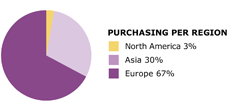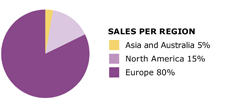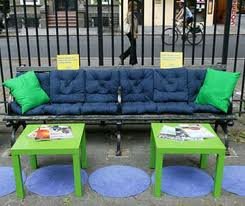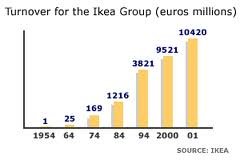Introduction
IKEA International is a global corporation that offers home accessories to all global clients. Headquartered in Sweden, IKEA provides quality furnishings and services in various global markets. To realize this vision, IKEA offers various properly designed and serviceable house-furnishings at very low prices across global markets. IKEA is acknowledged for the provision of quality furnishings that cannot be assembled easily, but can be transported without problems. IKEA furnishings are evident in the City Festivals and residential places.
Since its inauguration in 1943, IKEA has globalized its operations and businesses. However, globalization presents various threats and opportunities to IKEA while exposing its strengths and weaknesses to market competitors. The strategic marketing excellent issues relating to IKEA’s global operations are analyzed through Value Chain framework.
The current operations and business situations of IKEA
In the 1980s, IKEA began to expand its business operations to the United States and other parts of the European markets. These markets attracted the company due to several reasons: (1) the regions had very large customer base, (2) the local residents who had travelled were considered risk-takers, (3) the market was fragmented, and (4) the potential customers could be identified with regions. The success of IKEA business relied on the consumers sensitivity to the product attributes regardless of origin.

IKEA entry into the United States markets was focused on the consumers the company perceived to be the potential customers. The firm opened its first US store along the coastline. While going global, IKEA believed that people living along the coast and Islands were exposed to foreign products.
The reason to focus on the travelling consumers was that the company was determined to sell products with European standards. The success of such products would be uncertain in areas where consumers have no foreign experience. The success of this market entry mode in Europe was to form the basis for establishment before expanding marketing operations elsewhere.
The entry mode adopted by IKEA when expanding to the European markets occurred in form of a market-seeking investment undertaken to exploit new markets. The Swedish markets are saturated and the markets can only offer limited growth opportunities.
The company was motivated to this investment by the constant market growth and large market sizes of Europe, and IKEA aimed to serve the larger markets. In the European markets, IKEA was met with great success after focusing on providing the cheapest solutions to gain competitive advantage.
The success in the European markets was not a straightforward endeavor given that established firms that had huge capitals pursued foreign investments. Although IKEA had made a good fortune in the Sweden market, moving capital from the country was a challenge.
The capital controls in Sweden prohibited investing abroad with home gained capital. However, IKEA had to make quick profits and get a positive cash flow by adopting the foreign investments strategies. The company changed from offering European styled products to the American styled ones in the other global markets.
What IKEA could be doing right to reach consumers in different markets
IKEA Value Chain Analysis
Inbound logistics: In the European and USA, IKEA has established a wide base of producers and supplies responsible for manufacturing and supply of furniture parts. The extensive array of regional warehouses is integrated with an efficient management of inventory driven by the need to ensure that the right parts go to the right customer at the right time.
Storing the furniture components as a single package is a cost saving approach, as the stores need not to be as big as they might be expected for a furniture company. See diagram below for IKEA’s storage balconies.

Operations: IKEA has continued to expand and increase its customers across all market segments including Africa, Europe, Asia, and America. IKEA is the only firm in the global furniture industries that has managed to attract customers across the world without changing the original concept of management.
This has been achieved through the development of unique product designs based on sacred dedication. Other strategic operations include market and product research, which add to the competitive strength of the business. See charts below for IKEA’s sales per region.

Outbound logistics: In an industry that is considered local by many people, IKEA has become global because of its comprehensive distribution network. The firm now delivers low cost, but quality furniture to major markets such as Europe, and America. It is the only distributor in the industry to have established on a global scale.
It has stores spread in Europe, and North America and recently established operation in Asia. The low cost of distribution in the global markets is enabled through the innovative way of dealing with the logistic sourcing and retailing whereby the products are knocked down and shipped in flat boxes. These involve consumers in value addition process by transporting, and assembling the furniture by themselves.
Marketing and sales: IKEA marketing in the global markets is accomplished through the renowned IKEA catalogue, which has existed for years. This marketing tool is the cornerstone in the firm’s concept and is distributed free of charge to the households within the stores’ principal market areas. See diagram below for IKEA’s street marketing.

The sales returns generated by IKEA increase because of the numerous customers who visit the global stores. Every year, the company experiences an increase in the number of visitors due to the new products advertised though the catalogues. See graph below for IKEA returns.

Services: The great success of IKEA has been enabled through the homely services offered in the stores. The stores have been likened to IKEA homes where a customer can get any household services including dining, children playing zones and instructions on how to assemble products on their own.

This kind of high-level service maintains the attractiveness to and competitive advantage of the firm.

The pros and cons of the strategy used by IKEA
Through the strategy, IKEA has not been able to exploit various market opportunities. For instance, IKEA has various options to make sure it improves its marketing performances in the depressing economic setting founded on environmental dynamism and the state of the industry.
However, this can hardly be realized through its current strategy. Besides, to accommodate average regulars with minimal wages and discretionary expenditure powers, the strategy cannot allow IKEA to manufacture low priced designs. Thus, the company could invest in R&D to fund its expenses and improve on the status of its product designs. Through employing products promotion strategies, IKEA could widen its sales and become the market leader in the various nations.
The strategy however has some advantages. Its present promotional campaigns are based on cultural awareness and exclusive marketing situations for every nation and globally differ across marketplaces. To convey the alternative and innovative television spots across the world, IKEA has worked with diverse advertising bureaus for more than a year. Hence, IKEA gives the marketing agencies the liberty to discover some of the uncharted and fascinating ideas that generate additional attraction.
Through the strategy, IKEA stores across the globe appear positioned and arranged in a way that one cannot leave without seeing all the available products or furniture. This strategy lures the customers to buy IKEA products. IKEA takes advantage of this in getting new personnel to help customers walk through the shop and see the commodities they need. Thus, the system enables the clientele to buy more furniture than what they planned to purchase. Further, the company profits from the healthy firm-supplier association and its economies of scale.
Recommendations and conclusion
IKEA is cautious about the societal and cultural aspects of the markets where it operates. IKEA should provide a commission on its products and services and allow every department to make its own management and marketing decisions.
In the regional markets where IKEA currently functions, such preparations will ensure that assorted units can respond promptly to any state of crisis. Conversely, by focusing on the superiority and low manufactured goods overheads, IKEA should pursue the principle of reaching out to the cost conscious customers.
This can be realized via putting extra energy on its business operations and sourcing the supply chain resources to minimize the operation costs. Hence, IKEA International should reduce the resource leasing to lower the operating fixed costs. This can be realized through choosing a shopping quarter in the suburban areas while evaluating the existing guidelines.
While operating in the global markets, IKEA should provide excellent services during sales periods and over the weekends when the clients overwhelm personnel in service. For IKEA to sanction the employees to supply more than one category of manufactured goods, the company must cross-train its workforces in diverse fields. IKEA should let the deployment of workforce from other sections when a given sector faces many enquiries from the clientele.
The corporation must hire more part time workers from the nearby communities and train them appropriately. Finally, IKEA must make sure that there is recurrent upgrading of consumer services to make them remain its business contents whilst using technical internet shopping.